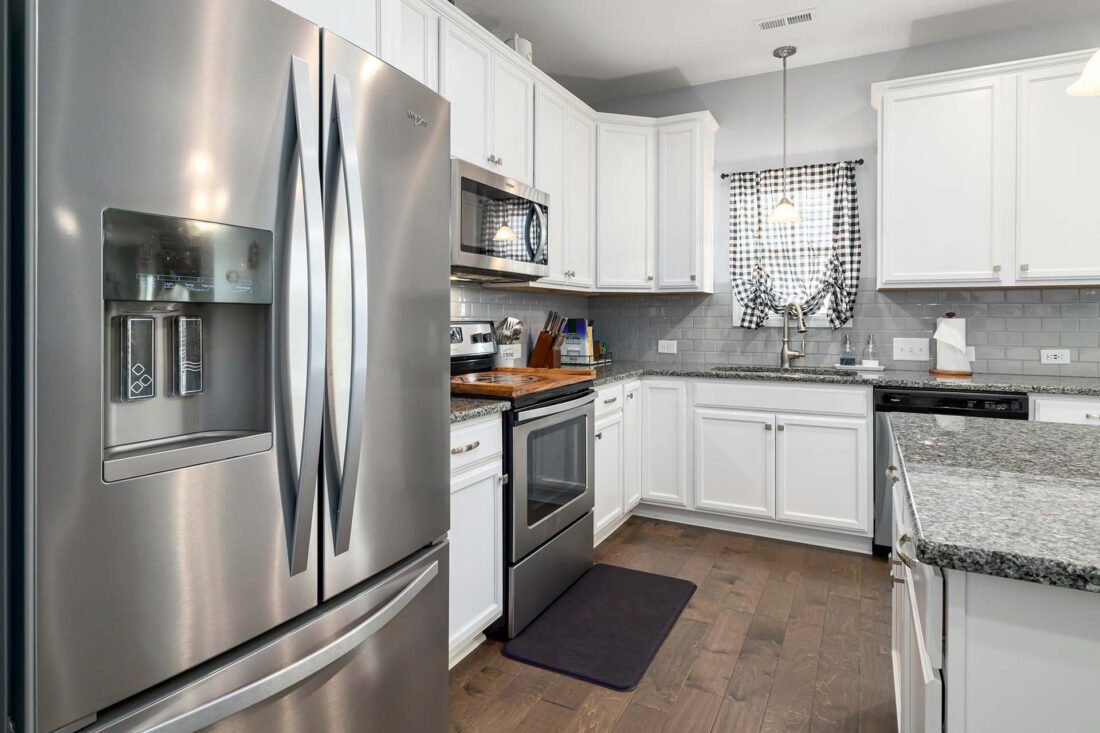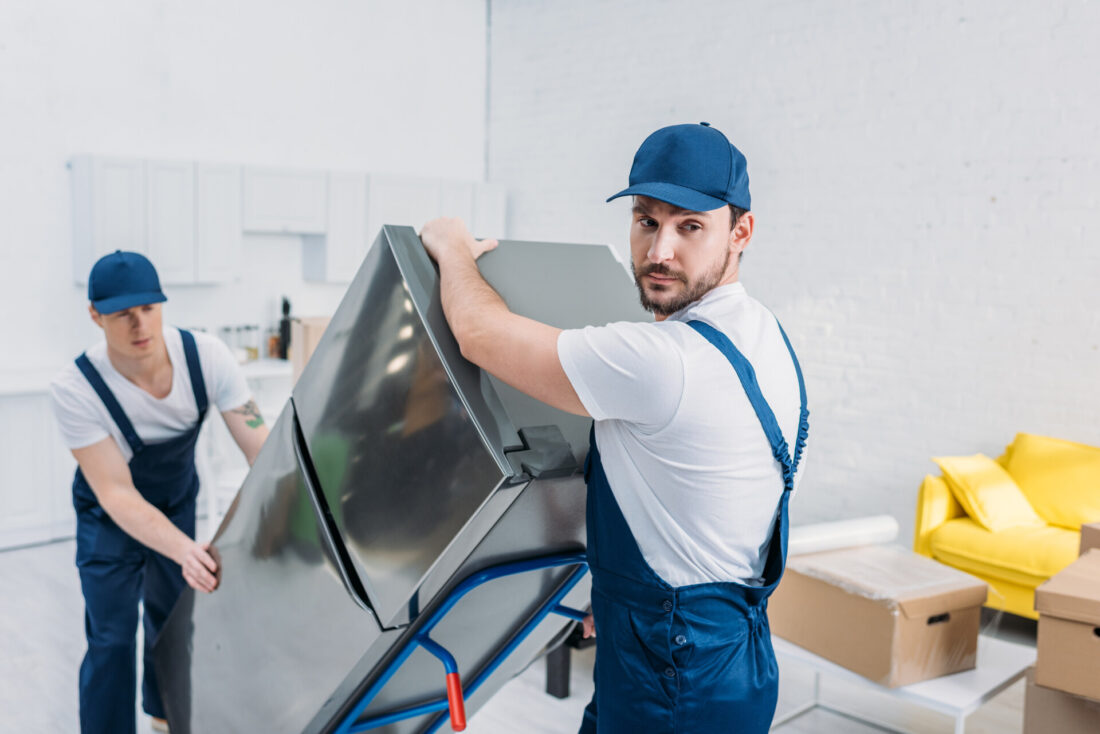Moving appliances can be a difficult task, but with the right strategies, it can also be surprisingly manageable. Whether you’re relocating a fridge or shuffling a washing machine, knowing how to move appliances safely is key to protecting these essential home items. We’ll walk you through some clever tips and tricks that make the process smoother and less stressful. So, grab your dolly and some moving straps!


How to Move Appliances Hassle-Free
Moving appliances doesn’t have to be a headache. To relocate safely, as well as pack efficiently, it’s essential to follow a few basic steps. First, ensure that all appliances are clean and dry. Disconnect and secure cords, and if possible, remove any loose parts or shelves. Use protective wrapping to prevent scratches and dents.
For larger items, consider simply hiring cross-country movers who specialize in this type of relocation. Their expertise can be invaluable, especially if you’re not accustomed to handling large items. By following these steps in our home appliance moving guide, you’ll ensure a smooth transition to the new home.
What if something gets damaged during the move? According to US News Money, appliances are cheaper from September to December and during the holiday weekend, so you can purchase everything at a lower price. Remember this, just in case. You never know!
How to Move Heavy Appliances Without Hurting Yourself
Relocating heavy appliances, like refrigerators, washing machines, and dryers, requires careful planning to avoid injuries. If you’re helping a friend relocate or tackling this task yourself, start by learning heavy appliance lifting techniques. Always lift with your legs, not your back, and use straps or a dolly to minimize physical strain.
If relocating across the country, it’s best to secure the services of professional movers such as Long Distance USA Movers, experienced in handling heavy items. They have the necessary equipment and know-how to relocate these bulky appliances efficiently, ensuring that both you and your appliances arrive in top condition.


Assess the Appliances’ Specific Needs
When preparing to organize to move, it’s crucial to know that each type of appliance has its unique requirements for safe appliance transportation. For instance, refrigerators need to be defrosted and their doors secured. Washers and dryers often require stabilizing the drum. Ovens, especially gas models, need careful disconnection and handling.
This diversity in needs can amplify the fear of relocating, as each appliance demands specific attention. The key to a smooth transition is to consult the user manual for each appliance. These manuals often contain vital information on how to prepare and relocate these items safely. Tailoring your approach to each appliance’s needs, you can ensure they are transported without damage.
What to Know About Pre-Move Preparation for Appliances
Preparing appliances for relocation involves several key steps to ensure a stress-free moving experience. Start by thoroughly cleaning each item, ensuring they are dry and free of residues. For refrigerators, defrost and dry the interior, and for ovens and microwaves, remove any crumbs or grease.
Handle detachable parts with care, removing shelves and drawers or securing them inside. Secure cords with tape to the back of each item to prevent tripping hazards. These preparations are vital things to do before relocating, ensuring that each essential is ready for a safe and efficient transition.
Essential Packing Materials and Supplies
When moving delicate electronic appliances, having the right packing materials is crucial. You’ll need blankets to protect the exterior of each item. Shrink wrap to keep doors and drawers in place.
You will also need packing tape for securing wrapping materials and furniture sliders to facilitate easier transport.
Bubble wrap is another essential supply, particularly for protecting detachable parts and smaller appliances. These materials not only safeguard your items during transit but also make the process of handling and transporting them much more manageable.


Disassemble All Detachable Parts and Start Packing
It’s essential to disassemble all detachable parts of your home essentials. This not only simplifies transportation but also helps prevent things from breaking during the journey. Carefully disconnect water hoses, ensuring they’re drained and dry.
For items with gas connections, such as certain ovens or dryers, ensure the gas is turned off and the connection is safely detached by a professional if necessary. Here’s a step-by-step guide to safely disassemble:
- Refrigerators – Remove shelves, drawers, and water filters. Secure doors with tape.
- Washers/dryers – Disconnect and drain hoses. Tape doors and lint traps shut.
- Ovens/stoves – If gas-operated, professionally disconnect gas lines. Remove racks and secure doors.
After disassembly, begin utilizing secure appliance packing methods. The best way to wrap breakables is by using bubble wrap or soft packing materials for internal parts like shelves or drawers. Secure these materials with packing tape to ensure they stay in place during transit.
How to Pack a Refrigerator
Start by unplugging it at least 24 hours before relocating to allow defrosting. Clean and dry the interior thoroughly to prevent mold and odors. Remove and separately pack all shelves and drawers, wrapping them in bubble wrap for protection.
To keep the doors from opening during transport, secure them with strong tape or a strap. A useful hack is to place a bag of baking soda inside to absorb any residual odors. Finally, wrap the exterior with blankets or padded covers, ensuring corners and handles are well-protected against bumps.
How to Pack a Washing Machine
When packaging a washing machine for relocation, the first step is to disconnect and drain all hoses, ensuring no residual water remains. Secure the drum, if possible, using the manufacturer-provided hardware or moving bolts to prevent internal damage. Protect the glass door with bubble wrap or a thick towel taped in place.
For the exterior, wrap the machine in moving blankets, paying extra attention to corners and buttons. A handy tip is to keep all cords, hoses, and screws in a labeled bag, taped to the side of the machine for easy reassembly.
How to Pack a Dishwasher
To pack a dishwasher, start by removing all racks and utensil holders and package them separately, using bubble wrap for protection. Ensure the dishwasher is completely dry inside to avoid mold growth. Tape the door securely shut and wrap the entire appliance in a blanket, securing it with tape.
For added protection, especially around the control panel, use additional layers of bubble wrap or padding. A useful tip is to mark the hoses and cables with colored tape for easy identification during reinstallation. This careful approach ensures your dishwasher stays secure and protected throughout the relocation process.
How to Pack a Coffee Machine
Next on your relocation to-do list is the coffee machine. If it has a glass carafe, remove it and wrap it separately in bubble wrap or a thick towel for protection. Detachable parts like the drip tray or filter basket should also be packed separately, ideally wrapped in bubble wrap or placed in a padded box.
For the main unit, wrap it in a layer of bubble wrap followed by a layer of packing paper or a small blanket, ensuring all sides are well protected. Secure the wrapping with tape. Placing the wrapped coffee machine in a sturdy box, ideally the original packaging if available, with additional packing material around it, will provide extra cushioning and prevent movement during transit.
Loading and Securing Appliances in the Moving Truck
On a relocation day, use a dolly or a furniture slider to transport each item to the truck. It’s important to load the heaviest appliances first, like refrigerators and washing machines, placing them against the back wall of the truck to distribute weight evenly.
Once inside, secure each item using straps or bungee cords. This is essential to prevent movement during transit. Padding around appliances with moving blankets or extra cushioning materials can provide additional protection.
Transporting Appliances – Vertical vs. Horizontal Placement
The placement of appliances in the relocation truck, whether vertical or horizontal, depends on their design and structure. Generally, appliances should be transported in the same orientation as they are normally used. Refrigerators, for example, are best transported vertically to prevent compressor oil from leaking into cooling lines.
Washing machines and dryers also fare better in a vertical position. However, certain items like ovens or dishwashers can be transported horizontally if properly secured and cushioned, though vertical is often still preferred. The key is to ensure stability and prevent movement. Vertical placement usually maximizes space and minimizes the risk of internal damage, but horizontal placement can be used for shorter, sturdier appliances.


When Is the Right Time to Hire Professional Appliance Movers
The benefits of relocating with long-distance movers become particularly apparent in scenarios when investing in cross-country moving services brings order to the whole process. If you’re facing a significant geographical shift, such as a cross-country move, enlisting a cross-country moving company can alleviate much of the stress and logistical challenges.
These cross-country movers offer comprehensive packing services, ensuring your items are safely and efficiently prepared for the journey. They possess the necessary equipment and expertise to handle heavy and delicate appliances, reducing the risk of damage. Find reliable movers online and check their legitimacy on the Better Business Bureau website.
Moving Services
Treat yourself with a white glove long distance moving service that’s based on the inventory list and not weight. This means a price guarantee, transparent move costs and premium moving service.
Learn moreAuto Transport
Move your car across the country in an open or enclosed trailer – for an affordable fee. We offer car transport as a standalone service, but you can bundle it with your household move and get a hefty discount.
Learn morePacking Service
Sit back and relax, we’ve got packing services covered. We use moving blankets, shrink wrap, bubble wrap and even custom wooden crating. Your stuff will be protected and carefully handled during the move.
Learn moreMake Everything Easy – Reach Out to Our Long-Distance Moving Company
Let Long Distance USA Movers company make it seamless for you. Our comprehensive long-distance moving services cover every aspect of your move, ensuring a stress-free experience. From the meticulous packing of coffee machines to the secure transport of larger essentials, we handle it all with expert care.
Our team is adept in heavy appliance lifting techniques, ensuring safe loading and securing in the truck. We understand the intricacies of both vertical and horizontal placement of appliances.
Whether you require assistance with moving services or need expert packing services, our team is here to support you. Contact Long Distance USA Movers to simplify the relocation.
How Do I Move a Refrigerator Without Causing Damage?
Begin by disconnecting it and allowing it to defrost for at least 24 hours. This prevents ice buildup from causing internal damage. Clean and dry the interior thoroughly to avoid mold and odors. Remove internal components like shelves and drawers, wrapping them separately.
Secure the doors with strong tape or moving straps to keep them closed during transit. Use a dolly to transport the refrigerator in an upright position, as tilting can cause damage to the cooling mechanism. Wrap the exterior with blankets for additional protection.
Can I Lay My Washing Machine on Its Side During the Relocation?
It’s generally not recommended to lay a washing machine on its side during relocation. This position can cause internal parts, especially the drum, to shift or become unbalanced, leading to potential damage.
If there’s no option but to transport it on its side, ensure it’s for the shortest duration possible. Secure the drum using transit bolts if available, and wrap the appliance in protective material to safeguard against scratches and dents.
What Should I Do With My Appliances a Day Before the Relocation?
A day before the transition, ensure all home essentials are fully prepped. This includes disconnecting them from power sources, draining water hoses, and securing loose parts. Refrigerators should be defrosted, cleaned, and dried.
For washers and dryers, the drum should be secured. Ensure gas connections for stoves and ovens are safely disconnected. This preparation minimizes the risk of damage and ensures essentials are ready for transit.
How Can I Secure the Doors of My Appliances During Transit?
To secure doors of home essentials during transit, use strong, reliable tape or moving straps. This is vital to prevent doors from swinging open, which can cause damage to the item and pose a safety hazard. Additionally, padding around the doors with soft materials can provide extra security and prevent scratches.
How Do I Protect the Glass Parts of My Appliances When Moving?
Glass parts, such as oven doors or microwave plates, require extra care when relocating. Wrap them in bubble wrap or a thick layer of packing paper, securing the material with tape. For larger glass components, use a cardboard cutout for additional protection. Place these items in a clearly labeled box to avoid accidental mishandling.
How Long Should I Wait Before Turning on My Appliances After the Relocation?
After relocation, it’s advisable to wait before turning on home essentials. For refrigerators and freezers, a waiting period of 24 hours is recommended to allow the oils to settle back into the compressor. Other appliances like washing machines and dryers can be used immediately, provided they are transported upright and securely.
What Are the Signs of Damage I Should Look For in My Appliances Post-Move?
Post-relocation, inspect home essentials for signs of damage. Listen for unusual noises when they are turned on, which could indicate internal issues. Check for physical damage like dents or scratches.
For refrigerators, monitor the cooling efficiency. In washers and dryers, watch for any imbalance or erratic behavior. Prompt identification of these signs can help address potential issues before they worsen.






